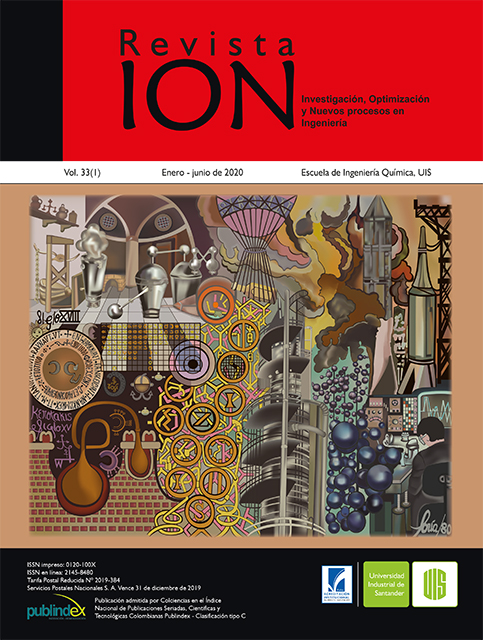Published 2020-06-30
Keywords
- Bioethanol,
- Pineapple Residues,
- Saccharomyces Cerevisiae,
- Waste Valorization
How to Cite
Abstract
In this work it was studied the production of ethanol from rejected-pineapple juice (that is, fruits that do
not meet the technical standards for marketing) from the department of Chocó. The raw material was
characterized and used in fermentations where the effect of the use of commercial yeast, the dilution of
the medium and the addition of supplements on the amount of alcohol produced at 72 h of reaction was
evaluated. The sugar profile and the characterization of this pineapple variety suggests that it corresponds
to a suitable substrate for obtaining alcohol without the need for additional nutrients or supplements.
Ethanol production using S. cerevisiae was close to 65 gL-1 in a medium of undiluted pineapple juice,
without the addition of nutrients and without temperature (between 23 and 38 °C) or pH (between 4.0 and
4.5) control. Under controlled temperature (30 °C) and pH (4.5) conditions, the time required to reach
the same yields decreased considerably (less than 15 hours). These results are expected to be useful in
the propose and develop of alternatives for the recovery of pineapple crop residues in the region and to
reduce the negative environmental impact that they represent.
Downloads
References
Fecha de consulta: Mayo, 2019.
[2] González, X. Panorama de la producción de piña en Colombia. La República. Disponible en: https://www.agronegocios.co/agricultura/la-produccion-de-pina-en-colombia-llegaria-a-118-millones-de-toneladas-al-finalizar-el-ano-2895397. Fecha de consulta: Mayo, 2019.
[3] Murcia J. Ensayos para la producción de etanol utilizando Ananas comosus de rechazo (tesis de grado). Medellín, Colombia: Universidad Pontificia Bolivariana; 2013.
[4] Murcia J, Barrera R, Zondervan E. Process design and techno-economic analysis of a pineapple wine production plant under the context of the Choco-Colombia region. Comput. Aided Chem. Eng. 2019; 46: 277-282.
[5] Banerjee S, Ranganathan V, Pattic A, Arora A. Valorisation of pineapple wastes for food and therapeutic applications. Trends Food Sci. Tech. 2018; 82: 60-70.
[6] Gil L, Maupoey P. An integrated approach for pineapple waste valorisation. Bioethanol production and bromelain extraction from pineapple residues. J. Clean. Prod. 2018; 172: 1224-1231.
[7] Sanewski G, Bartholomew D, Paull R. The pineapple: botany, production and uses. Wallingford: CAB International; 2018.
[8] Roda A, Lambri M. Food uses of pineapple waste and by-products: a review. IJFST. 2019; 54: 1009-1017.
[9] Idiata D, Lyasele J. Waste To Wealth: Production of Bioethanol From Pineapple Waste. JMEST. 2014; 1(4): 282-287.
[10] Tropea A, Wilson D, La Torre L, Lo Curto R, Saugman P, Troy-Davies P, Dugo G, Waldron K. Bioethanol production from pineapple wastes. J. Food Res. 2014; 3 (4): 60-70.
[11] Boletín informativo: Biocombustibles hoy No. 189. Disponible en: https://www.fedebiocombustibles.com/nota-web-id-3064.htm. Fecha de consulta: Mayo, 2019.
[12] Bullock, GE. Review of emerging ethanol technologies. Bioenergy review, 2003; 2 (2): 30-36.
[13] Lin Y, Tanaka S. Ethanol fermentation from biomass resources: current state and prospects. Appl. Microbiol Biotechnol. 2006; 69; 627-642.
[14] Alain K, Georges N. Aka Y. Ethanol production from pineapple cannery juice in co´te d´lvoire whith preselected yeast strains. J. Ferment Technol. 1987; 65, 475-581.
[15] Nigam J. Continuous ethanol production from pineapple cannery waste using immobilized yeast cells. J. Biotechnol. 2000; 80 (2): 189-193.
[16] Rivera E. Costa A, Atala D, Maugeri F, Maciel M, Maciel R. Evaluation of optimization techniques for parameter estimation: Application to etanol fermentation considering the effect of temperature. Process Biochem. 2006; 41: 1682-1687.
[17] Delgado-Huertas H, Arango-Wiesner L. Caracterización morfoagronómica de genotipos de piña
(Ananas spp.) en un suelo de terraza alta de Villavicencio. ORINOQUIA. Universidad de los Llanos - Villavicencio, Meta. Colombia. 2015; 19 (2): 153-165.
[18] Cheftel J, Cheftel H. Introducción a la Bioquímica y Tecnología de los Alimentos (vol I). Zaragoza: Acribia, 1992.
[19] USDA. Basic report: 09266, Pineapple, raw, all varieties. United States Department of Agriculture, National Agricultural Library. Disponible en: https://www.nal.usda.gov/. Fecha de consulta: mayo de 2019.
[20] Kruckenberg A. The hexose transporter family of S. cereviciae. Arch. Microbiol. 1996; 166 (5): 283-292.
[21] Ingledew W. Alcohol production by S. cerevisiae: a yeast primer. En: The Alcohol Textbook: A Reference for the Beverage. Fuel and Industrial Alcohol Industries. Jacques K, Lyons T, Kelsall D, editors. Nottingham, UK: Nottingham University Press; 1999.


